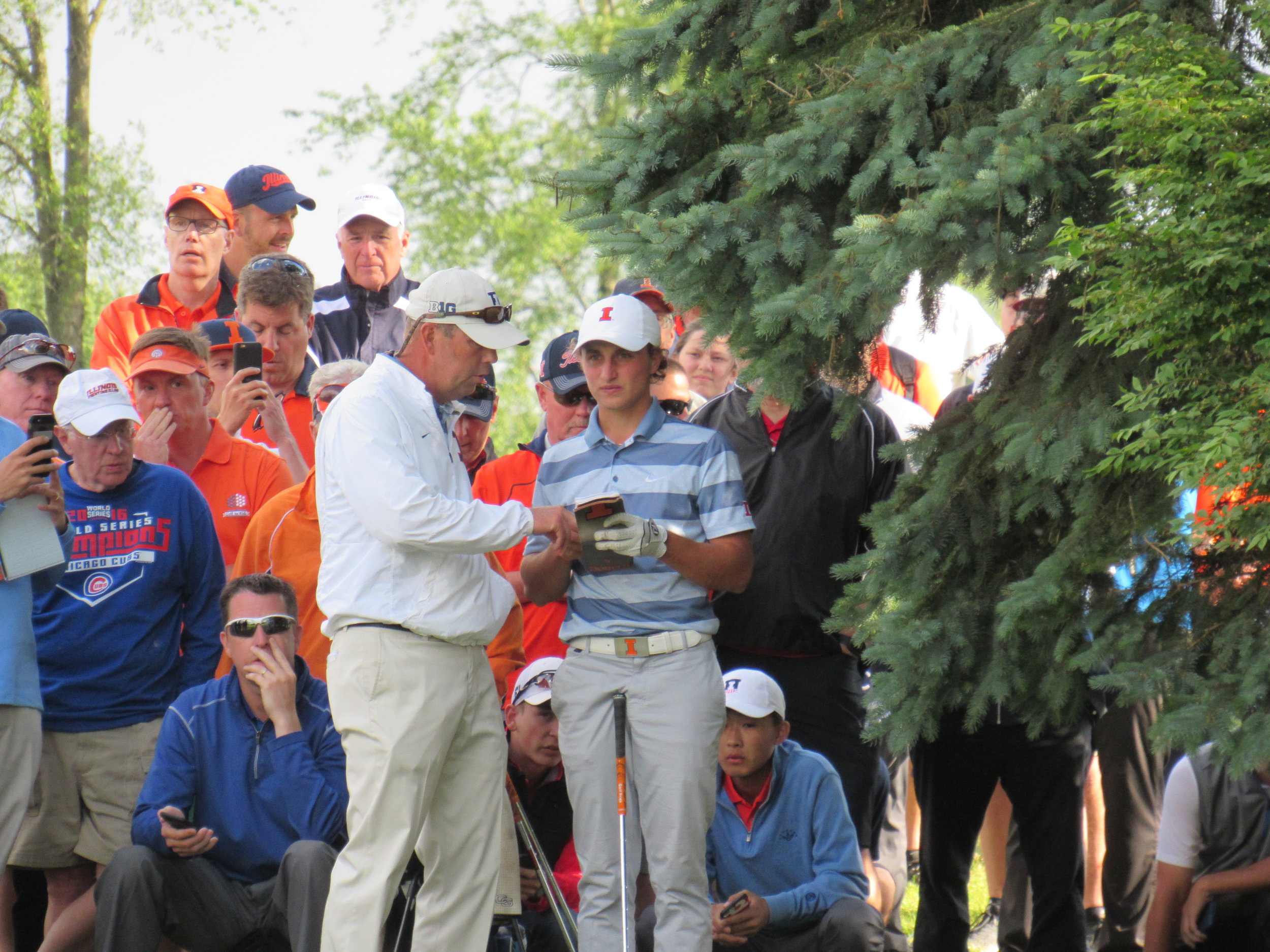I spent last week at the NCAA Championship, taking in the action of the nation’s best collegiate golfers and the future stars of the game. In recent years, I have thoroughly enjoyed the television coverage and found the format and team competition intoxicating. In person it’s even better.

The event has vaulted into one of my favorite golf events of the year. Over the course of the week, I watched a ridiculous amount of golf and had a lot of random thoughts.
The ball-striking era
Since Mark Broadie’s revolutionary book, Every Shot Counts, was published in 2014, the philosophy that ball-striking wins golf tournaments has become the focus of competitive golfers and aspiring professionals. The results of this philosophical change are evident with today’s collegiate golfers: Almost everyone smashes it 300-plus off the tee and possess beautiful golf swings that maximize their ability to generate distance.
What I believe this movement is leading toward is a commoditization of the golf swing; an era where everyone hits the ball really well and the difference between the guys who win continuously and those who don’t will be a combination of their mental game, their play inside of 125 yards and their ability to hole putts. Like any industry, the pendulum swings and currently it has swung far past center towards the side of ball-striking. Soon it will return to center with a balanced look at all aspects of the game.
Rico Suave
One of my favorite college players, USC’s Rico Hoey, played his final rounds as an amateur last week. Next, he will turn professional and take his game to the Canadian Tour, with a few PGA Tour sponsor’s exemptions sprinkled in.
If you are looking for a young player to root for, here he is. Hoey had a unique upbringing, which wasn’t filled with country club golf and riches. Born in the Philippines, his family eventually moved to Southern California, where Hoey and his older sister learned the game of golf, spending hours at local munis and earning scholarships and eventually All-American honors. He plays the game ultra-aggressively, pulling driver on holes where most hit iron. He regularly hits driver off the deck and has a great laid-back and friendly personality.
Rico goes driver off the deck on the 2nd tee to take a little off. He's missed one fairway today, the 18th which is 5 yards wide. pic.twitter.com/BXSN9ZLLXM
— the fried egg (@the_fried_egg) May 30, 2017
His teammates call him “WGD,” short for World’s Greatest Driver. It’s an apt nickname; Hoey is one of the best drivers of the golf ball I have ever seen. His go-to shot is a towering cut that travels 300+ yards and rarely misses the fairway. When his wedge game is clicking, Hoey can go low, evidenced by his second-round 66 at Rich Harvest Farms, where he was -7 through 11 holes. Like many young players, Hoey will have to improve his consistency with his wedges and if he does so, he could be a great player at the next level.
The Lifetime Achievement Award?
If you were holding a vote for this year’s “best college golfer in the United States” (a combination of amateur and collegiate seasons), which of these players would you vote for?
Player A:
2016-17 Collegiate season: One collegiate win, seven top 10s, nine top 25s in eleven events
2016-17 Amateur Season: Qualified for the U.S. Amateur but failed to make match play and made the cut at a Web.com Tour event.
Player B:
2016-17 Collegiate Season: Three collegiate wins, three second-place finishes, eight top 10’s, eleven top 25’s in twelve events, Conference Player of the Year
2016-17 Amateur Season: Won the 2016 Western Amateur, Quarterfinalist in the U.S. Amateur, T4 at the Jones Cup Invitational.
Player C:
2016-17 Collegiate Season: Three collegiate wins, four second-place finishes, 12 top 10’s, 13 top-25’s in thirteen events. Conference Player of the Year, nation’s best scoring average and no finish worse than 13th.
2016-17 Amateur season: Finished sixth in stroke play portion of the U.S. Amateur, won the Colorado Amateur and finished 20th in the Western Amateur stroke play.
If you picked Player A, you are (somehow) correct!
This is what happened with this year’s Hogan Award, which went to Stanford’s Maverick McNealy, who beat out Illinois’ Dylan Meyer (Player B) and Oregon’s Wyndham Clark (Player C).
McNealy had been a finalist for the award the past two years, losing to Jon Rahm, and it seems the committee felt they owed McNealy the award for his legacy’s sake.
McNealy has had a phenomenal career at Stanford and remarkable seasons – six wins in his sophomore season and four wins in his junior season. His senior campaign very strong but not among the top five in college golf, let alone the best of the best.
The Hogan Award committee’s decision damaged the legacy of two other deserving golfer’s careers, costing them the valuable future sponsorship dollars and potential playing opportunities that are associated with being an award winner.
The best thing I saw all week
USC Coach Chris Zambri reading putts.

Talk about #TourSauce, Zambri apparently putts like this too!
The Popovich of College Golf
The University of Illinois made a great run, advancing to the semifinals of the championship and making their fifth consecutive match play appearance, the longest active streak of any school. Head Coach Mike Small has built the nation’s most respected and consistent program, something no one thought possible for a northern school.

Small’s calling card for success has been player development, recruiting players who fit his mold and making all of them significantly better players year over year. Each seems to leave ready for professional golf or life upon graduation. Besides player development – like Popovich – Small is quick and to the point in interviews and also has a knack for finding international players who blend effortlessly into his system.
DJ D-Funk
One of Illinois’ star players, Dylan Meyer, is an interesting case study.
Many question his ability to play at the next level because he lacks the prodigious length of other prospects. I think he will have a long career because he owns his game and has the nuance that many players lack until their 30s. He is a master of spin control, something that makes him one of the nation’s best inside 125 yards – and also a great wind player. The key for Meyer will be simply making it to the Tour, where there are enough courses that suit his game (Harbour Town, TPC Deere Run, Sea Island, Waialae, Sedgefield, etc.). The danger lies in him getting stuck on the Web Tour, where bomb and gouge courses are prevalent.

I liken Meyer’s game to a wide receiver who runs a 4.7-second 40-yard dash, but has crisp route running skills that make him unguardable. In an era filled with bombers, his game is different but just as effective, especially when the golf course requires precision and nuance.
A #Innovative Idea
One of the aspects of college golf that bothers me is a team’s ability to host regional championships and national championships at their home course.
This year’s championship was hosted by Northern Illinois, a team that hardly would be considered a powerhouse program, but next year the finals move to Karsten Creek, home to the likely preseason No. 1 Oklahoma State Cowboys.
In my opinion, championships must be played on a neutral site. The issue is that it’s difficult to find courses accommodating enough to give up their course for a week during regionals and two weeks for the men’s and women’s national championships. My solution would require a little collaboration between the NCAA and the PGA Tour, but I believe it’s one that would be mutually beneficial: Have the championships hosted at TPC Courses across the country. This gives the NCAA “neutral” sites across the country that are built to host championship golf, while the PGA Tour benefits by having the future stars of the game exposed to the public at an early age on their courses, adding valuable marketing appeal to players when they reach the Tour level.
The one hurdle would be the TPC’s loss of revenue, but it seems like something that could be overcome with a little work.
Other quick observations
• NCAA Champion Oklahoma has some players who look like they should be playing football rather than golf. Junior Rylee Reinertson hits the ball about as hard as I have ever seen a competitive golfer hit it.
Rylee Reinertson, a class in disassociating the lower and upper body #NCAAGolf pic.twitter.com/Tgi6TtZDpl
— the fried egg (@the_fried_egg) May 30, 2017
• Oregon freshman Norman Xiong is the real deal. Xiong joined the Ducks in the spring after graduating high school early and he hardly looks like an 18 year old – at 6’2”, Xiong has effortless power and a beautiful golf swing. Xiong fits the mold of today’s modern golfer and looks like he could grow into a Dustin Johnson-type body. It will be fun to watch Xiong’s game progress over the next few years.
More action from @OregonMGolf Xiong yesterday amazing this kid is only 18 #NCAAgolf pic.twitter.com/YIeLMR9lDc
— the fried egg (@the_fried_egg) May 30, 2017
• College golf is a business affair. During the practice rounds, Rich Harvest Farms was crawling with reps from equipment manufacturers and agents, all looking to sign the next big thing.
• Rich Harvest Farms has A+ facilities and the land to host a major championship. Everything from volunteers to parking was top notch. The big drawback is the golf course and its routing.
• Braden Thornberry is rock solid and it looks like he is destined to take over Jim Furyk’s throne as the owner of the PGA Tour’s most unique golf swing. While it isn’t pretty, Thornberry is in perfect position to rip it on his downswing. With six wins this year, the proof is in the pudding.
• Illinois Italian sophomore Edoardo Lipparelli is set to turn professional, a decision that surprised many. The Italian possesses a world of potential and may have the most talent of any player on the Illinois roster. His talent could make him one of Europe’s top players, but I think he would have been best served staying at Illinois and developing his skills under the eye of Mike Small, just like Thomas Pieters and Tom Detry did before him.
• The best player I saw this week was Oregon’s Wyndham Clark. What impressed me most was his short game, something with which young players with his power rarely excel. It should be fun to watch him as a professional this summer, which will include starts at the Travelers and John Deere Classic. Listen to our podcast with Wyndham.


 by
by 
